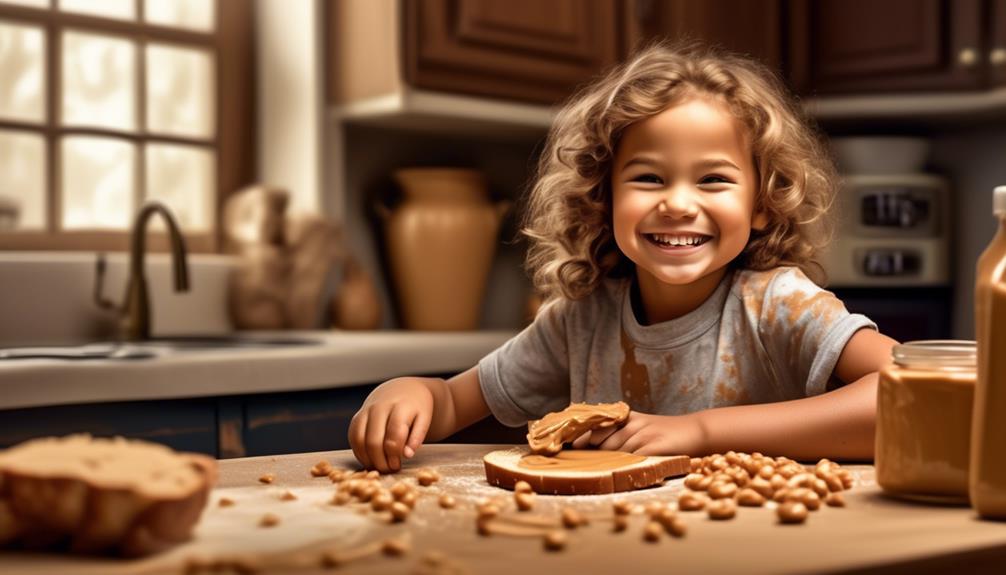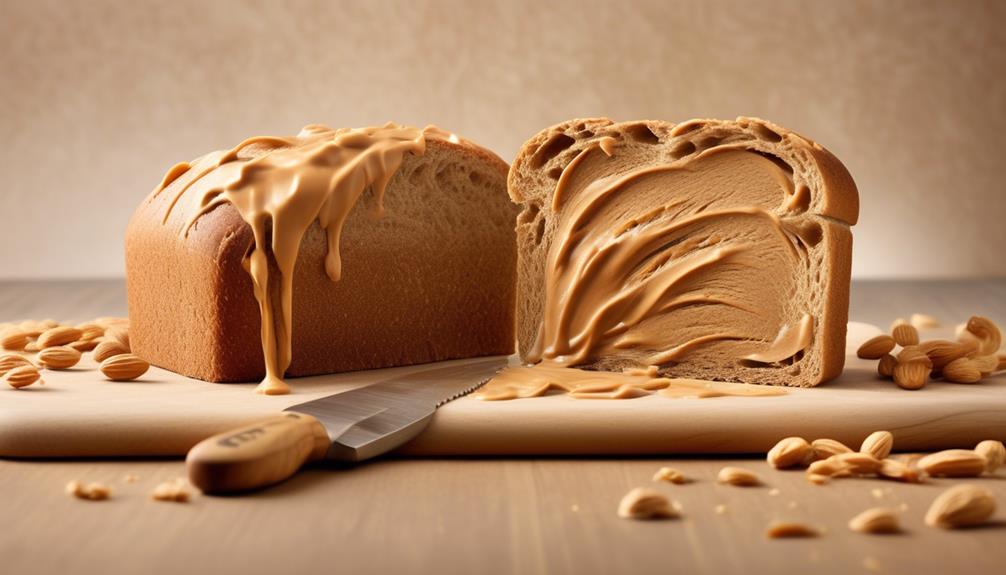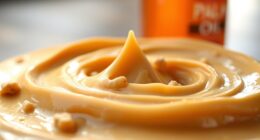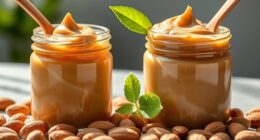Let’s discuss the process of enjoying a peanut butter cup. Unwrap it, pause to savor the sweet fragrance, and then delight in the first bite – these are the essential yet simple steps to fully enjoy a perfect peanut butter cup.
But there's more to it than just the initial taste. It's about finding the right balance of flavors and textures, exploring different techniques, and perhaps even incorporating it into unexpected culinary creations.
So, how does one truly master the art of enjoying a peanut butter cup? Well, let's just say there's a lot more to it than meets the eye.
Key Takeaways
- Unwrapping and admiring the peanut butter cup is the first step in the art of eating it, appreciating the chocolate shell and savoring the aroma.
- Taking small nibbles or gentle bites allows for a slow and enjoyable experience, allowing the flavors to meld together.
- Exploring different bite sizes and experimenting with pairing the peanut butter cup with beverages can enhance the overall experience.
- Sharing the joy with others, incorporating peanut butter cups into dessert recipes or savory dishes, and finding your own perfect ritual can add to the enjoyment of eating a peanut butter cup.
Unwrapping the Peanut Butter Cup
Gently and carefully remove the paper wrapping from the Reese's Peanut Butter Cup to reveal the delectable combination of chocolate and peanut butter inside. When unwrapping the peanut butter cup, it's important to peel back the edges of the wrapper without applying too much pressure to avoid squishing the chocolate and peanut butter. Take care to handle the cup delicately, ensuring that the chocolate shell remains intact. Using your fingers, peel off the wrapper in a way that preserves the structural integrity of the chocolate and peanut butter.
The anticipation builds as the wrapper comes off, savoring the moment before indulging in the first bite.
The process of unwrapping the peanut butter cup is a crucial step in the overall experience of eating a Reese's Peanut Butter Cup. It sets the stage for the sensory delight that follows and allows for a moment of anticipation and appreciation of the treat. By carefully unwrapping the peanut butter cup, we ensure that the chocolate and peanut butter are presented in their optimal condition, ready to be enjoyed.
Admiring the Chocolate Shell

How can one fully appreciate the smooth and glossy appearance of the chocolate shell of a Reese's Peanut Butter Cup? As we gaze upon the delectable confection, our eyes are drawn to the lustrous sheen of the chocolate coating, hinting at the velvety mouthfeel it promises. Upon closer inspection, the outer edges reveal a delicate ripple pattern, evidence of the meticulous craftsmanship that has gone into creating this indulgent treat.
With an anticipatory bite, the chocolate shell yields with a satisfying snap, offering a moment of sensory delight before the rich flavors unfold on the palate. As the teeth break through the outer layer, the contrast in textures becomes evident, the firm resistance of the chocolate giving way to the smooth creaminess within. This interaction of textures, the juxtaposition of the crisp chocolate shell against the soft, yielding peanut butter, adds depth to the tasting experience, elevating it beyond mere consumption to a moment of genuine appreciation.
As we take the time to admire the chocolate shell, we're preparing ourselves for the sensorial journey that lies ahead, building anticipation and savoring the anticipation of what's to come.
Savoring the Aroma

As we shift our focus from admiring the chocolate shell to savoring the aroma, we can engage our senses in a new facet of the peanut butter cup experience. Savoring the aroma of a Reese's peanut butter cup is an essential part of the enjoyment. The rich aroma of chocolate and peanut butter is a prelude to the delightful indulgence that follows. It's a sensory experience that heightens the anticipation and sets the stage for the flavors to come.
To fully appreciate the aroma of a peanut butter cup, follow these steps:
| Savoring the Aroma of a Reese's Peanut Butter Cup |
|---|
| Hold the peanut butter cup close to your nose |
| Inhale slowly, allowing the sweet scent to envelop your senses |
| Appreciate the delightful blend of nutty and chocolatey notes |
| Close your eyes and focus on the warm, comforting fragrance |
Savoring the aroma of a peanut butter cup enhances the overall pleasure of the experience, intensifying the anticipation and adding depth to the enjoyment of each bite.
Taking a Small Nibble

As we take a small nibble from the peanut butter cup, we can appreciate the delicate combination of flavors and textures.
With each gentle bite, we can savor the rich and creamy peanut butter filling, complemented by the smooth chocolate exterior.
Taking our time to enjoy each small nibble allows us to fully experience the indulgence of the peanut butter cup.
Gentle Bite
To savor the combination of chocolate and peanut butter, take a small, gentle bite to delicately break the surface without crushing the entire cup. Apply just enough pressure to experience the smoothness of the Reese's peanut butter as you take a delicate nibble. This allows you to fully appreciate the flavor and texture.
Slowly chew the small piece to prolong the enjoyment, allowing the rich flavors to unfold. Many enthusiasts share their gentle bite experiences on social media, with hundreds of thousands joining in the celebration of this delightful and satisfying process.
Slow Enjoyment
Slowly savoring the intricate blend of chocolate and peanut butter, one should take a small, deliberate nibble to fully appreciate the rich and decadent flavors of the peanut butter cup. As we delve into the art of slow enjoyment, let's consider the following:
- Allow the flavors to dance on your taste buds, indulging in the creamy peanut butter and smooth chocolate with each tiny bite.
- Let the sensory experience unfold gradually, relishing the sweetness and savory notes that linger on your palate before taking another nibble.
- Embrace the leisurely pace, taking your time to fully immerse yourself in the indulgent taste of the iconic Reese's peanut butter cup.
In this moment of intimate enjoyment, remember that there's no wrong way to relish the experience. Just nine simple ingredients, yet the pleasure derived is immeasurable.
Sinking Your Teeth in

Sinking our teeth into a peanut butter cup yields a satisfying crunch as the smooth chocolate shell and creamy peanut butter center merge in a delightful contrast of textures. Taking a big bite allows the creamy peanut butter and chocolate to melt in our mouths, creating a rich and indulgent experience. As we enjoy the contrast of textures, the combination of the rich, sweet flavors tantalizes our taste buds, creating a truly satisfying sensation.
To fully appreciate the experience of sinking our teeth into a peanut butter cup, it's important to savor each bite and allow the flavors to linger on our taste buds. The slow enjoyment of this delectable treat amplifies the pleasure and indulgence. Here's a guide to savoring every bite:
| Sinking Your Teeth In | Enjoyment Tips |
|---|---|
| Feel the satisfying crunch | Take a big bite |
| Let the flavors melt | Allow the peanut butter cup to linger on your taste buds |
| Savor the rich, sweet flavors | Slowly relish the combination of chocolate and peanut butter with each bite |
| Enjoy the contrast of textures | Ensure to slowly savor and enjoy the combination of chocolate and peanut butter with each bite |
Savoring a peanut butter cup is an intimate experience that brings together the delightful contrast of textures and the rich, sweet flavors, creating a truly indulgent moment.
Letting the Flavors Meld

As we let the flavors meld, we can expect an intricate interplay of the creamy peanut butter and the rich chocolate.
The contrast in textures and the gradual melting process allow us to savor the complex combination of flavors.
Taking the time to enjoy each bite slowly will enhance our overall experience and appreciation of the peanut butter cup.
Flavor Combination
To fully appreciate the flavor combination of a peanut butter cup, allow the peanut butter and chocolate to mix on the tongue by taking a small bite and letting it sit in the mouth for a few seconds before chewing.
This technique allows the flavors to meld, creating a harmonious blend of sweet and nutty notes. As the peanut butter cup rests in your mouth, savor the luxurious fusion of creamy peanut butter and rich chocolate as it tantalizes your taste buds.
Press the peanut butter cup against the roof of your mouth with your tongue, letting it melt slightly to intensify the flavor experience. By allowing the contrasting textures to soften in your mouth before chewing, you can fully appreciate the delightful interplay between the smooth peanut butter and the velvety chocolate coating.
Texture Contrast
Exploring the textural contrast of a peanut butter cup involves allowing the flavors to meld in the mouth, enhancing the experience of the rich chocolate and creamy peanut butter. To fully appreciate this aspect, we should pay attention to the initial crunch of the chocolate shell and the smoothness of the peanut butter filling. Allowing the chocolate and peanut butter to mix together before chewing is crucial for experiencing the full effect of the texture contrast. The creamy texture of the peanut butter and the rich, velvety texture of the chocolate create a harmonious blend. Below is a table highlighting the importance of texture contrast in savoring a peanut butter cup:
| Texture Contrast | Description | Importance |
|---|---|---|
| Initial Crunch | The initial sensation of the chocolate shell breaking | Creates anticipation for the creamy peanut butter |
| Smooth Peanut Butter | Creamy, smooth texture that complements the chocolate | Enhances the overall mouthfeel and flavor experience |
| Harmonious Blend | When the textures meld, creating a satisfying mix | Elevates the indulgent experience of the peanut butter cup |
Savoring the combination of textures is essential for fully appreciating the indulgent experience of a Reese's Peanut Butter Cup.
Enjoying Slowly
Slowly savoring a small bite of the peanut butter cup allows the flavors of the chocolate and peanut butter to meld in the mouth, enhancing the overall taste experience.
- As the chocolate begins to melt, it creates a luxurious, velvety coating around the peanut butter, intensifying the creaminess of the filling.
- Allowing the flavors to mix in your mouth before swallowing enhances the complexity of the taste, revealing subtle undertones of sweetness and nuttiness.
- By closing your eyes and focusing on the rich, creamy texture as you slowly chew, you can fully appreciate the decadent combination of flavors.
Taking the time to savor each bite allows the sweetness of the chocolate and the nuttiness of the peanut butter to blend together on your palate, creating a truly indulgent experience.
Exploring the Peanut Butter Core

Gently biting into the Reese's Peanut Butter Cup reveals the creamy core, allowing for a rich and smooth peanut butter filling to be savored. The thick peanut butter center provides a delightful contrast to the chocolate shell, creating a unique sensory experience.
As we explore the peanut butter core, we can experiment with different methods to fully appreciate its creamy texture and nutty flavor. Licking it out slowly can intensify the pleasure, allowing the taste to linger on the palate. Alternatively, scooping the core with a spoon offers a more controlled and deliberate approach, enhancing the tactile experience.
The combination of flavors within the peanut butter core is truly a marvel to behold, with the sweetness of the chocolate complementing the savory richness of the peanut butter. Every bite uncovers a symphony of tastes that can be enjoyed in solitude or shared with a fellow connoisseur.
The exploration of the peanut butter core is a journey of indulgence, where every moment is an opportunity to savor the intricate layers of this beloved treat.
Experimenting With Different Bite Sizes

We can experiment with different bite sizes to explore how they affect the taste and texture of the peanut butter cup. When it comes to enjoying a peanut butter cup, the size of the bite can greatly impact the experience. Here are a few ways to experiment with this:
- Take a small nibble to savor the flavors before biting into the whole cup. This allows you to appreciate the layers of chocolate and peanut butter individually before experiencing them together.
- Consider taking multiple small bites to enjoy the cup over a longer period of time. This method allows you to savor each bite slowly, prolonging the enjoyment of the treat.
- Experiment with biting off the edges first and then savoring the middle. By doing this, you can experience the contrasting textures of the chocolate coating and the creamy peanut butter center in a deliberate sequence.
Pairing With a Beverage

We will now explore the beverage pairing options for enjoying a Reese's Peanut Butter Cup.
We'll discuss how certain beverages complement the flavors of the peanut butter cup.
Additionally, we'll analyze the importance of serving temperature in enhancing the overall experience of consuming a peanut butter cup with a beverage.
Beverage Pairing Options
When considering beverage pairing options for enjoying a peanut butter cup, various complementary choices can be explored to enhance the overall taste experience.
- Pair with a glass of milk for a classic and comforting combination.
- Enjoy with a cup of hot coffee to contrast the sweetness of the peanut butter cup.
- Try pairing with a cold glass of iced coffee for a refreshing twist.
Flavor Complements
Exploring flavor complements for pairing a beverage with a peanut butter cup yields a range of delightful options to enhance the overall taste experience.
| Beverage | Flavor Complements |
|---|---|
| Cold Milk | Classic pairing experience |
| Rich and Bold Coffee | Enhances chocolate and peanut butter flavors |
| Smooth and Creamy Hot Chocolate | Comforting and indulgent combination |
| Sweet and Fruity Red Wine | Surprising and delightful flavor contrast |
| Hoppy and Robust Craft Beer | Complements the richness of the peanut butter cup |
Each beverage offers a unique way to elevate the enjoyment of a peanut butter cup. Whether it's the classic combination of a cold glass of milk, the boldness of a rich coffee, the indulgence of hot chocolate, the surprise of a fruity red wine, or the complement of a craft beer, the right pairing can enhance the flavors and create a truly delightful tasting experience.
Serving Temperature
Pairing a peanut butter cup with a beverage requires considering the serving temperature to achieve an optimal flavor combination.
- Enjoy the peanut butter cup at room temperature for the best flavor experience.
- Pair with a cold glass of milk or a hot cup of coffee for a delightful combination of flavors.
- Consider pairing with a chilled glass of red wine for a unique and indulgent treat.
Pairing the peanut butter cup with the right beverage at the ideal temperature can elevate the taste experience.
The rich and creamy texture of the peanut butter cup is wonderfully complemented by the coolness of milk or the warmth of coffee.
Additionally, the contrasting flavors of a chilled red wine can create a luxurious pairing.
It's essential to consider the serving temperature of both the peanut butter cup and the accompanying beverage to fully appreciate the harmonious blend of flavors.
Freezing for a Unique Experience

To achieve a unique and enjoyable texture, consider freezing a peanut butter cup for a few hours, resulting in a satisfyingly cold and crisp experience.
Freezing the peanut butter cup transforms its texture, creating a delightful contrast between the frozen chocolate exterior and the creamy peanut butter filling. The cold temperature enhances the crunch of the chocolate shell, offering a new dimension to the sensory experience.
As the frozen treat slowly melts in your mouth, the smooth, cold interior of the peanut butter cup provides a refreshing sensation that's both indulgent and invigorating.
Experimenting with freezing different types of peanut butter cups allows for a variety of tastes and textures, providing an opportunity to explore the nuances of each variation. Whether it's the classic milk chocolate or the rich dark chocolate, freezing a peanut butter cup adds a layer of complexity to its flavor profile.
This unique experience of biting into an icy peanut butter cup is sure to delight the senses and elevate the enjoyment of this beloved treat.
Sharing the Joy With Others

Consider sharing the joy of savoring a Reese's Peanut Butter Cup with others to enhance the experience and create moments of delightful indulgence.
- Sharing with a friend or loved one allows for the creation of shared memories and strengthens the bond over the mutual enjoyment of the delectable treat.
- It fosters a sense of intimacy and connection, as the act of sharing food has been shown to promote positive social interactions and feelings of closeness.
- It provides an opportunity to introduce someone to the blissful combination of chocolate and peanut butter, giving them a chance to experience the sheer delight of the flavor pairing for the first time.
- Incorporating Reese's Peanut Butter Cups into social gatherings or parties can add an element of fun and surprise, allowing others to partake in the enjoyment and savor the treat in their own unique way.
Incorporating Into Dessert Recipes

When incorporating peanut butter cups into dessert recipes, there are several delicious ways to use them. First, melting them to use as a topping for ice cream or cake can add a delectable and indulgent touch. The creamy texture of the melted peanut butter cups complements the cold, smooth ice cream or the soft, moist cake, creating a delightful contrast of temperatures and flavors.
Another option is to chop peanut butter cups and mix them into cookie dough. This provides a sweet and crunchy addition, elevating the ordinary cookie into a decadent treat. The melted peanut butter cups create pockets of gooey goodness that are irresistible.
For a more surprising twist, try using peanut butter cups as a filling for brownies or cupcakes. This adds a burst of rich peanut butter flavor that takes these classic desserts to a whole new level. The combination of the fudgy brownie or moist cupcake with the creamy peanut butter filling is a match made in dessert heaven.
If you're a fan of cheesecake, consider incorporating chopped peanut butter cups into a creamy peanut butter cup cheesecake recipe. This creates a dessert that's both rich and indulgent, satisfying the cravings of any peanut butter lover. The peanut butter cups add a delightful texture and flavor to the smooth and creamy cheesecake.
Lastly, for those who enjoy milkshakes or mousse, blending chopped peanut butter cups into a milkshake or incorporating them into a smooth and creamy peanut butter cup mousse can offer a delightful twist to classic dessert recipes. The addition of the peanut butter cups creates a luscious and satisfying experience, perfect for any peanut butter enthusiast.
Incorporating peanut butter cups into dessert recipes opens up a world of possibilities. Whether you choose to melt them, chop them, or use them as a filling, these sweet treats are sure to add a delicious touch to any dessert creation.
Incorporating Into Savory Dishes

We can create a savory peanut butter sauce by melting peanut butter cups and drizzling it over grilled chicken or pork for a unique sweet and savory glaze.
Incorporating peanut butter cups as filling for savory empanadas or hand pies can add a surprising twist to these dishes.
Adding chopped peanut butter cups to a spicy chili can provide a hint of sweetness and richness, enhancing the overall flavor profile.
Savory Peanut Butter Sauce
Incorporating the savory peanut butter sauce into various dishes introduces a rich, nutty flavor that enhances the overall culinary experience.
The versatility of this sauce allows for a multitude of applications, such as:
- Adding it to stir-fries for a delectable, nutty undertone that pairs perfectly with vegetables and protein.
- Drizzling it over grilled chicken or tofu to infuse the dish with a savory and indulgent peanut flavor.
- Using it as a marinade for meats or vegetables before grilling or roasting, imparting a deep, nutty essence to the dish.
This sauce can truly elevate the taste profile of a wide range of savory dishes, adding a unique and satisfying dimension to each culinary creation.
Peanut Butter Cup Chicken
Utilizing chopped peanut butter cups as a topping for a chicken stir-fry introduces a surprising and indulgent twist to the savory dish, enhancing its flavor profile with a unique sweet and nutty essence. The combination of tender chicken with the rich, creamy texture of melted peanut butter cups drizzled over grilled chicken creates a delightful sweet and savory glaze.
Incorporating chopped peanut butter cups into a chicken salad provides a surprising sweet and salty twist, adding a delightful crunch and burst of flavor.
Stuffing chicken breasts with peanut butter cups before baking results in a decadent and flavorful main course, offering a delightful contrast of textures and tastes.
Additionally, creating a peanut butter cup sauce to accompany grilled or roasted chicken offers a unique flavor combination, adding depth and richness to the dish.
Not Letting a Crumb Go to Waste

To fully savor every morsel, ensure that no crumb is left uneaten when enjoying a peanut butter cup. Embracing the essence of indulgence, we must meticulously attend to every detail of this delectable treat. Here's how we ensure not a single crumb goes to waste:
- Use your tongue as a precision instrument to clean up any remaining peanut butter or chocolate clinging to the cup's interior. The tongue's dexterity allows for an intimate exploration of every nook and cranny, capturing every last bit of flavor.
- Lick your fingers with a sense of reverence, savoring any lingering remnants of the rich peanut butter and velvety chocolate. This tactile experience heightens the enjoyment of the peanut butter cup, leaving no trace of its existence behind.
- Employ a deliberate scraping technique to gather any remaining residue from the wrapper. Every speck of flavor is worthy of attention, and the wrapper holds the promise of a final, satisfying taste.
Finding Your Perfect Peanut Butter Cup Ritual

Experiment with various eating techniques to discover your ideal way to savor a peanut butter cup, whether it involves biting, peeling, or savoring slowly. To aid in this exploration, we have compiled a table below outlining different methods and their potential benefits.
| Eating Technique | Description | Potential Benefits |
|---|---|---|
| Biting | Directly biting into the peanut butter cup for a quick and straightforward consumption. | Immediate satisfaction |
| Peeling | Carefully peeling off the chocolate to savor the peanut butter filling separately. | Enhanced focus on peanut butter flavor |
| Savoring Slowly | Slowly enjoying each bite, letting the flavors linger on the taste buds. | Heightened sensory experience |
| Whole Consumption | Eating the entire peanut butter cup in one go. | Complete and uninterrupted enjoyment |
| Partial Consumption | Consuming the peanut butter cup in portions, savoring it over time. | Prolonged enjoyment, avoiding overindulgence |
Frequently Asked Questions
Is Peanut Butter Cup Good for You?
Peanut butter cups aren't considered a healthy snack due to their high sugar and fat content. Moderation is key; excessive consumption can lead to health issues.
While they offer some nutritional benefits from protein and healthy fats, the added sugar and processed ingredients outweigh these. Opting for dark chocolate or natural peanut butter options can make them slightly healthier, but portion sizes and overall nutritional value should be considered when incorporating them into your diet.
Why Do Reese's Cups Have Ridges?
We think Reese's cups have ridges for multiple reasons.
First, the texture and mouthfeel of the ridges provide a unique sensation while eating.
Additionally, they help contain the peanut butter, preventing spillage.
The ridges also serve a practical purpose by offering a better grip, making the cup easier to handle.
Lastly, they contribute to the distinct visual appearance that makes Reese's cups easily recognizable.
Why Do People Like Peanut Butter Cups?
We love peanut butter cups for their irresistible combination of sweet and salty flavors, creating a satisfying taste experience.
The creamy peanut butter filling and smooth chocolate coating provide a rich and indulgent texture.
This classic treat offers the perfect balance of flavors and textures, making it an enjoyable snack.
Additionally, the convenience and portability of the individually wrapped cups make them easy to enjoy on-the-go, adding to their appeal.
What Does Peanut Butter Cup Taste Like?
A peanut butter cup tastes like a perfect harmony of creamy peanut butter and smooth milk chocolate. The sweet and slightly salty flavor of the peanut butter blends seamlessly with the rich sweetness of the chocolate.
The combination of nutty, buttery, and chocolatey flavors creates a delightful experience that melts in your mouth. The smooth, velvety texture and comforting taste leave us craving for more.
Conclusion
In conclusion, indulging in a peanut butter cup is a truly delightful experience.
The combination of smooth peanut butter and rich chocolate creates a flavor explosion in your mouth.
Remember to savor every bite and appreciate the intricate layers of this delectable treat.
It's a taste sensation that will make you feel like you're on cloud nine.
So go ahead, treat yourself to a peanut butter cup and enjoy the pure bliss it brings.










